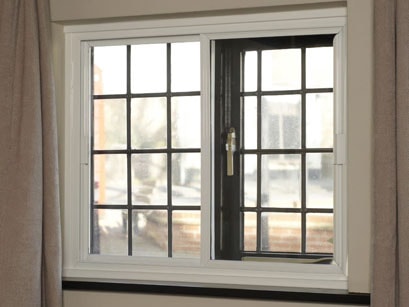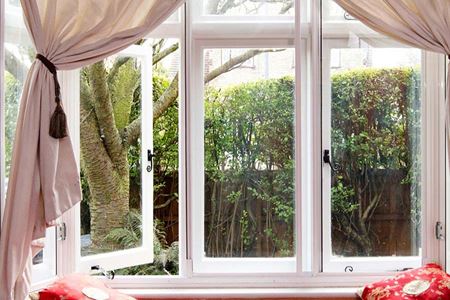What is Secondary Glazing?
Secondary glazing is a window fitted behind an existing one. This adds insulation and helps reduce outside noise without the cost and mess of completely replacing a window. Secondary glazing is often a solution for single glazed listed properties where window replacement is not an option.
Explore Secondary Glazing Window Types
Secondary glazing comes in a range of styles to suit different properties and window types.
Reasons to Choose Secondary Glazing
-
Reduce Outside Noise
Secondary glazing adds a layer of sound insulation which helps reduce outside noise. This is particularly useful if your home has single glazed windows or has rooms facing onto a busy road.
-
Easy to Maintain
A more discreet alternative to replacing your windows, secondary glazing needs little upkeep, requiring the occasional clean and lubrication. The glass panels can even be removed to make for easy cleaning when required.
-
Tough and Secure
Made from strong aluminium, Secondary glazing frames provide a strong barrier behind your existing windows. Having a window fitted behind an existing window ultimately improves overall security.
-
Cost–Effective Solution
With a faster installation process and fewer materials, secondary glazing can be more affordable than replacing all your windows. This can make it a good temporary or permanent solution for improving the energy efficiency of your home without the expense of new double glazing.
-
Adds an Insulating Layer
Installing secondary glazing adds another barrier that helps prevent draughts and cold air coming through your windows. This helps to lower the energy consumption of your home and reduce energy bills in the colder months.

Working with the Best Industry Bodies to Install the Best Secondary Glazing
Take a look at our industry accreditations and partnerships to see how we build quality into everything we design and manufacture. From the best in customer service to sustainable materials, we always aim for the highest standards.
Choose Anglian for a National Company Local to you
10-year Guarantee
A 10-year parts and labour guarantee is included in your Anglian double glazing price.
Made in Britain
Our products are made from start to finish in a British factory by skilled craftspeople.
Price Match
If you find cheaper like for like uPVC windows elsewhere, we'll match the price.
Customer Reviews
Secondary Glazing Explained

How Does Secondary Glazing Work?
Secondary Glazing sits behind existing single or double glazed windows. The gap between the windows adds a layer of insulation, helping stop warm air leaving your room and cold air getting in. This space also reduces the amount of sound that can travel through your windows from the outside into your room.

Do You Need Planning Permission for Secondary Glazing?
Secondary glazing is ideal for period properties that are either listed or in a protected area because it does not tend to need planning consent. So long as the secondary glazing is reversible and installing it would not damage the fabric of the building, frames of the existing windows or other protected features, then it should not need planning permission.

How Much Does Secondary Glazing Cost?
Because no one home is the same, the cost of secondary glazing is unique to each customer and their needs. How much secondary glazing costs is determined by the size of the window opening the requirements for installation. To get the perfect fit and benefit from as much thermal and sound insulation as possible bespoke secondary is the best option.
How Do you Clean Secondary Glazing?
Side-hinged: To clean the inside of side-hinged secondary windows, open them fully and clean them as you would the outside.
Horizontal sliders: If your windows open on a horizontal slider, then follow the instructions to take them out of the sliders and clean the panels individually.
Vertical sliders: Secondary windows on vertical sliders can be tilted open to allow for easy cleaning.
Our Happy Customers
“Anglian’s secondary glazing was the perfect solution for our listed building, as we couldn’t replace our windows with uPVC. We were very happy with everything and now we have a warmer home with no draughts.”
Mr Pearson, Derbyshire
Product Image: White uPVC sliding sash window with secondary glazing


Live Chat Now
Live chat with our friendly British based experts, or book an appointment, 24hrs a day.
Decide if Secondary Glazing is right for your home
Your Questions on Secondary Glazing Answered by Us
Secondary glazing can help reduce the chance of condensation forming your windows. Condensation is formed when warm moist air meets a cold surface. Secondary glazing sits behind windows that are exposed to colder temperatures, creating a barrier between them and the rest of your home. This minimises the chances of condensation forming and keeps the warm air inside.
It is not possible to say how much heat secondary glazing would save for your home, because that varies depending on the window it sits behind. What is undoubtedly true is that secondary glazing provides a noticeable difference to heat retention in a room. The extra layer of air and glass reduces the amount of heat that can transfer through to the window and outside, helping to keep your home warmer.
Secondary glazing can be a cost-effective investment for the long-term value of your home. The increased energy efficiency, noise reduction, and security can add value to your property, making it more appealing for potential buyers.
Secondary glazing can be an effective solution for many properties, particularly period homes that can’t be fitted with modern double glazing. The extra layer of glass and the air space behind it will make a big difference in reducing heat loss and outside noise, making them very much worth it for many properties. They represent a cost-effective option for any home where you can’t or don’t want to replace the original windows with modern double glazing.
Secondary glazing can last for at least a decade to beyond 20 years, so long as they are properly maintained. Our bespoke secondary glazing is made from durable materials and professionally fitted for perfect and reliable use for many years.
Because secondary glazing provides an extra layer of insulation, it helps to reduce condensation and therefore reduces the chances of mould forming on your windows. While it won’t eliminate this problem altogether, it can help keep it under control during the winter months.
Explore Similar Products



Home Improvement Provider









































